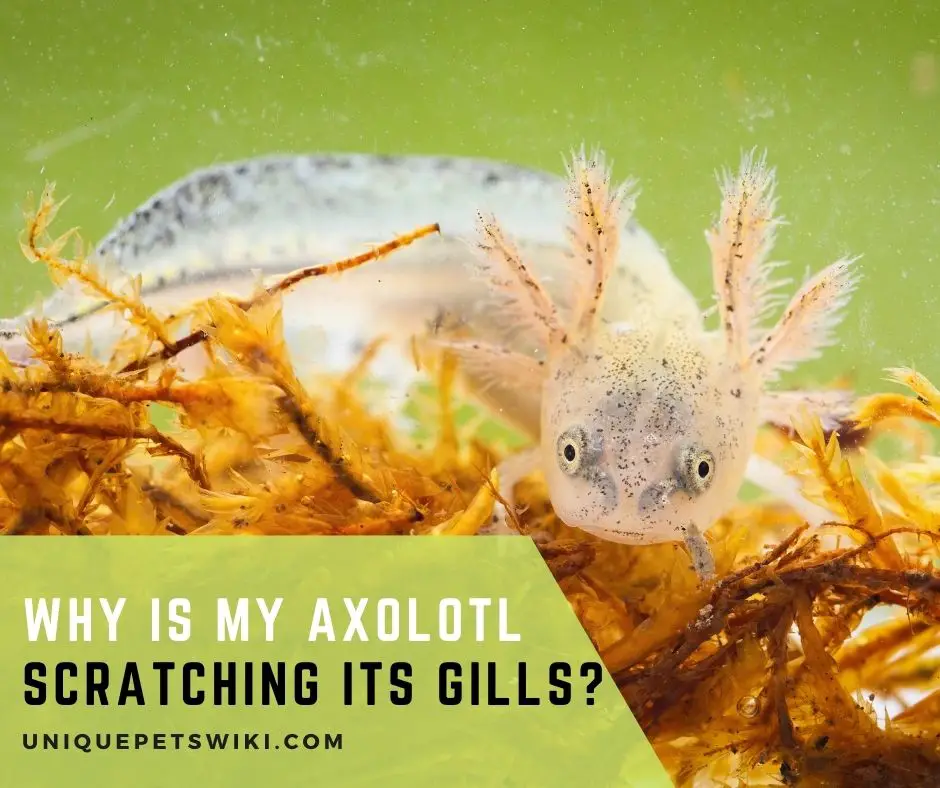Axolotls, like other marine animals, breathe through their gills. Axolotls, on the other hand, have gills that are located outside of their bodies.
The body has three pairs of gills protruding from it. Axolotls’ health is determined by the color and pattern of their gills. So, Why Is My Axolotl Scratching Its Gills?
Axolotls are delicate creatures who show a variety of signs when they are sick or agitated.
Axolotls are sensitive to bacterial and fungal illnesses, and these infections manifest in different ways in different axolotls.
As a result, it’s important to understand the background and causes of gill scratching.
The purpose of this article is to educate readers on the reasons and causes of axolotl gill scratching.
The information in this article will also assist you in understanding water quality and illnesses that cause gill scratching.
So, read the content all the way to the end to learn how to keep your gills from scratching.
Contents
Why Is My Axolotl Scratching Its Gills?
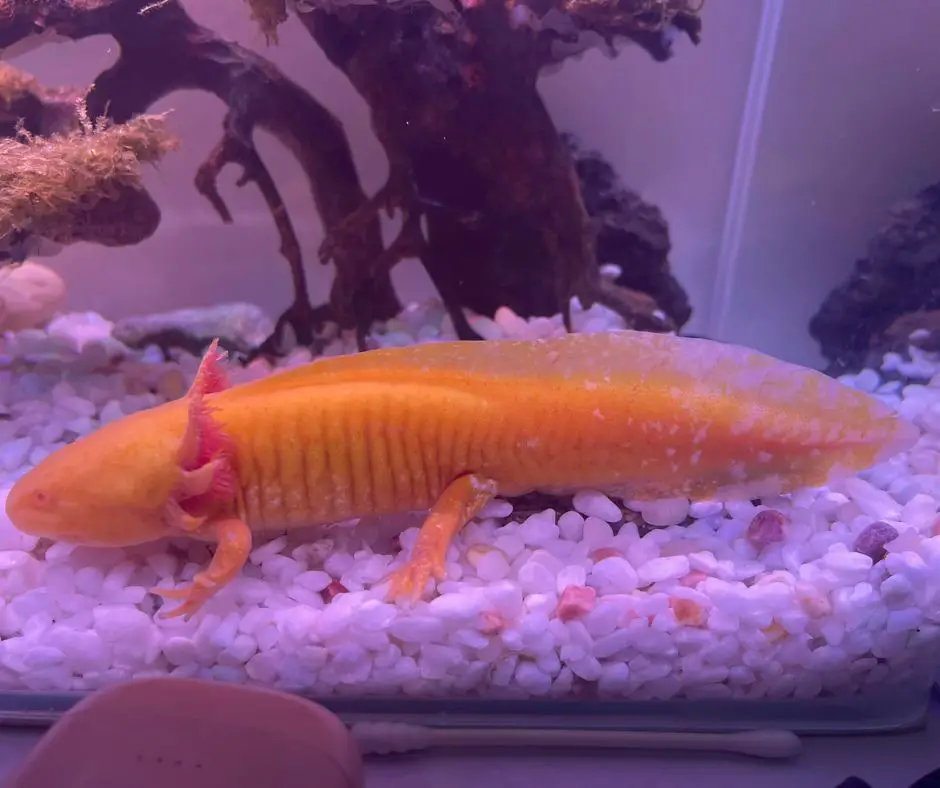
Depending on the underlying indications and symptoms, axolotl gill scratching might be normal or pathological.
Because axolotls also scratch their gills occasionally. Scratching the gills on maintains the gill cells active and respiring oxygen.
If an axolotl scratches its gills repeatedly, it could be an indication of bacterial or fungal infection. The state and condition of the gills are a reflection of the tank’s water parameters and environment.
Axolotls scratch their gills due to overcrowding, poor water quality, and low oxygen levels.
The increased amounts of ammonia, nitrates, and nitrites in the tank irritate the gills, causing axolotls to scratch their gills. Poor water quality also stresses axolotls, causing them to scratch their gills.
Stress
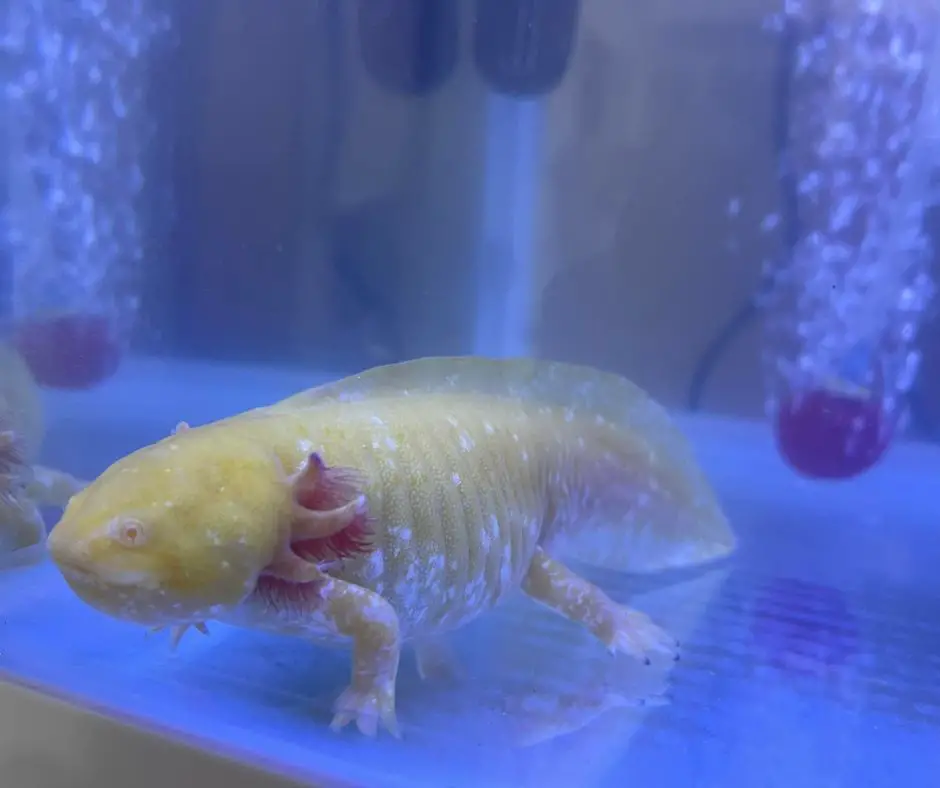
Axolotls’ immune systems are suppressed by stress, making them vulnerable to a variety of illnesses.
When axolotls are stressed, they exhibit behaviors including gill scratching, frequent gulping of air at the water’s surface, and lethargy.
The signs of stress in axolotls are lethargy, loss of appetite, floating at the surface, and lumps.
Low oxygen levels, new tanks, inappropriate water changes, warmer temperatures, unhealthy nitrogen cycles, and inadequate tank management are all stress-inducing factors.
The placement of filters in the tank, according to experts, produces some current that can stress axolotls.
Maintain water parameters, set up a salt bath, ensure proper feeding, and enhance water quality by changing it on a regular basis to reduce stress in axolotls.
Also read: 10 Axolotl Stress Signs
API Water Test Kit
- Contains one (1) API FRESHWATER MASTER TEST KIT 800-Test Freshwater Aquarium Water Master Test Kit, including 7 bottles of testing solutions, 1 color card and 4 glass tubes with cap
- Helps monitor water quality and prevent invisible water problems that can be harmful to fish and cause fish loss
- Accurately monitors 5 most vital water parameters levels in freshwater aquariums: pH, high range pH, ammonia, nitrite, nitrate
- Designed for use in freshwater aquariums only
- Use for weekly monitoring and when water or fish problems appear
Last update on 2022-12-30 / Affiliate links / Images from Amazon Product Advertising API
Water Quality Issues
Alterations in the water quality are the main causes of stress, floating, infections, and scratching of gills in the axolotls.
Axolotls become stressed when the water quality is low and float to the surface of the water to gulp the air.
Ammonia, nitrates, and nitrite levels in the tank should all be zero. The health of axolotls can be threatened by an increase in the concentration of any of these stress-inducing factors.
The presence of food residues in the water, warm water, and not changing the water for a long period are all contributing to the changes in water quality.
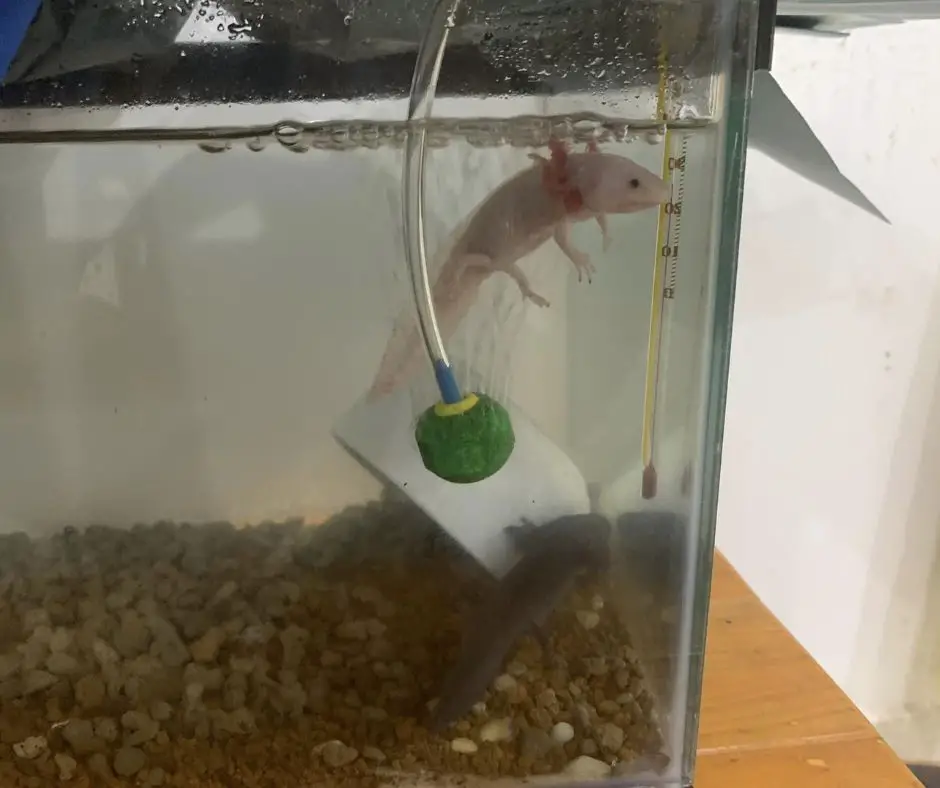
Axolotls are stressed by the presence of food residues and contaminations in the water, which alters the PH of the water.
Even when the water quality appears to be fine and clean, axolotls are still anxious. This is owing to the water’s low dissolved oxygen concentration.
Regularly testing the PH, ammonia, nitrates, and nitrites levels can help to preserve water quality.
You may use various kits to examine the quantities of ammonia, nitrates, and nitrites in tank water, and you can also use these kits to assess the water quality.
The quality of the water can also be maintained by changing it on a regular basis.
This will aid in the removal of food residues and other contaminants. Aside from that, you can add water filters and pumps to the tank to boost the oxygen levels.
Also read: Full Requirements & Water Conditions for Axolotl in Captivity
Sign of Bacterial Infection on Axolotl Skin
Bacterial infections are common in axolotls. Skin sores, redness, cloudy gills, cotton-like growths on the skin, and itchy skin are all indicators of bacterial infections.
When infections become severe, they can lead to gill degeneration.
The bacterial infection causes gill filaments to fall out. Because the pathogen kills filamentous cells, the gills’ ability to absorb oxygen is reduced.
Gill filaments infected with bacteria induce irritation and itching, prompting an axolotl to scratch.
Bacterial infections are caused by poor water quality and axolotls dwelling in toxin-laden water.
Bacteria can proliferate in the presence of food residues, high PH, and other contaminants. The axolotls’ skin and gills become diseased when they reside in such water.
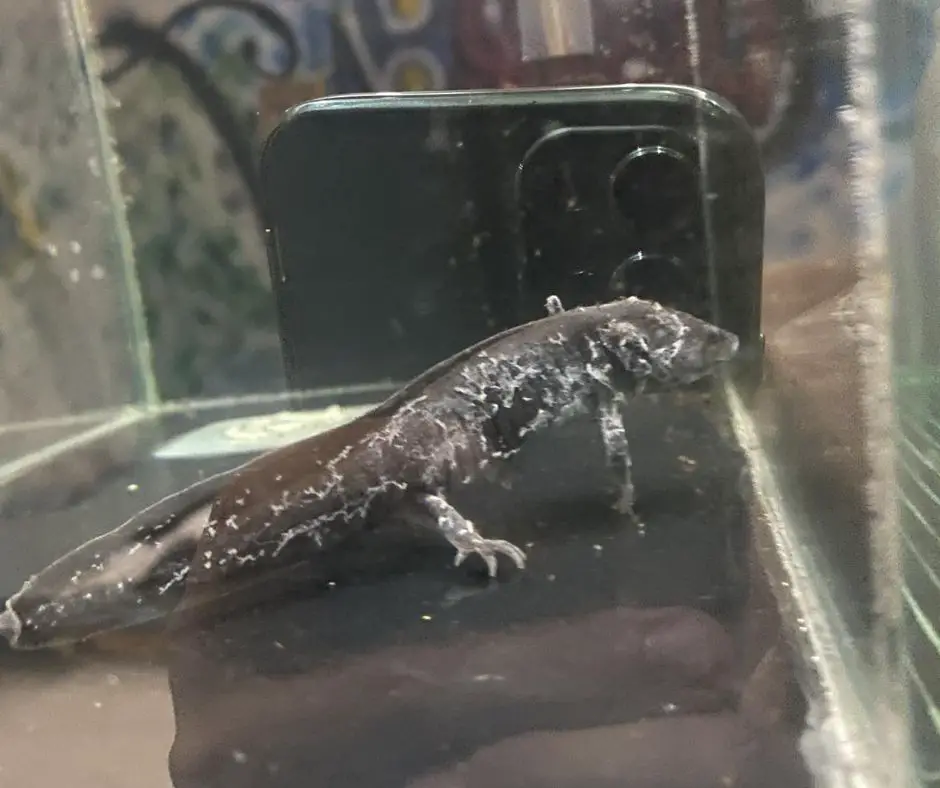
Maintaining proper water conditions is the most important step to preventing bacterial infections in axolotls.
Check the water chemistry on a regular basis, and if you notice any changes, see an expert or a veterinarian.
Axolotls should be treated with salt to treat and prevent bacterial illnesses.
When salt is dissolved in water, it possesses antibacterial properties and inhibits bacteria from growing in the water and on the skin of axolotls.
To prevent bacterial infections, proper water cycling is also required. Because cycling eliminates poop and food residue particles and inhibits the growth of bacteria.
So, by changing and cycling the water on a frequent basis, you can keep it fresh, clean, and bacteria-free.
Also read: 6 Common Axolotl Skin Conditions
Have Sand Stuck in Their Gills
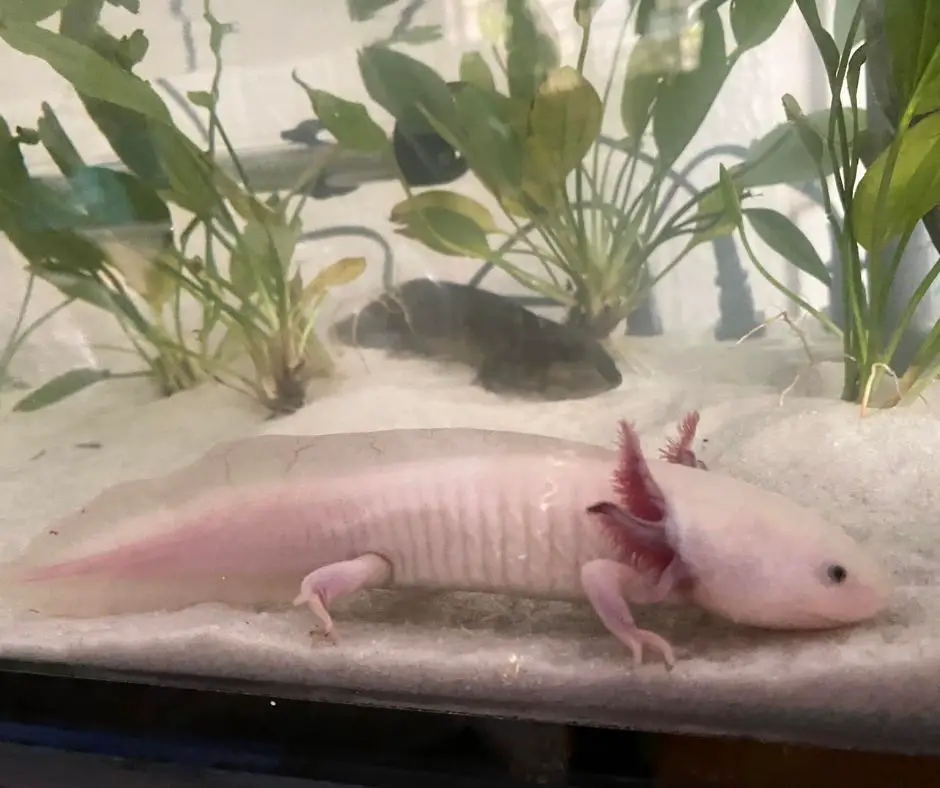
The aquarium is adorned with sand to make it more appealing. While adding, sand can get stuck in the rackers of gills. Axolotls scratch their gills to remove sand, which can be uncomfortable and irritating.
The presence of sand in the gill rackers can reduce the gills’ ability to absorb oxygen. because the surface area exposed to water to absorb oxygen diminishes due to the presence of sand.
As a result, the sensory cells in the gills force axolotls to scratch and remove sand particles in order to restore normal oxygen absorption.
So, while adding sand to the tank, remove the axolotl and return it when the sand has been added. For a short time, increasing the water flow can aid in the removal of sand from the gills.
Also read: 2 Best Aquarium Sand for Axolotl
What Should You Do When Axolotl Scratches Its Gills?
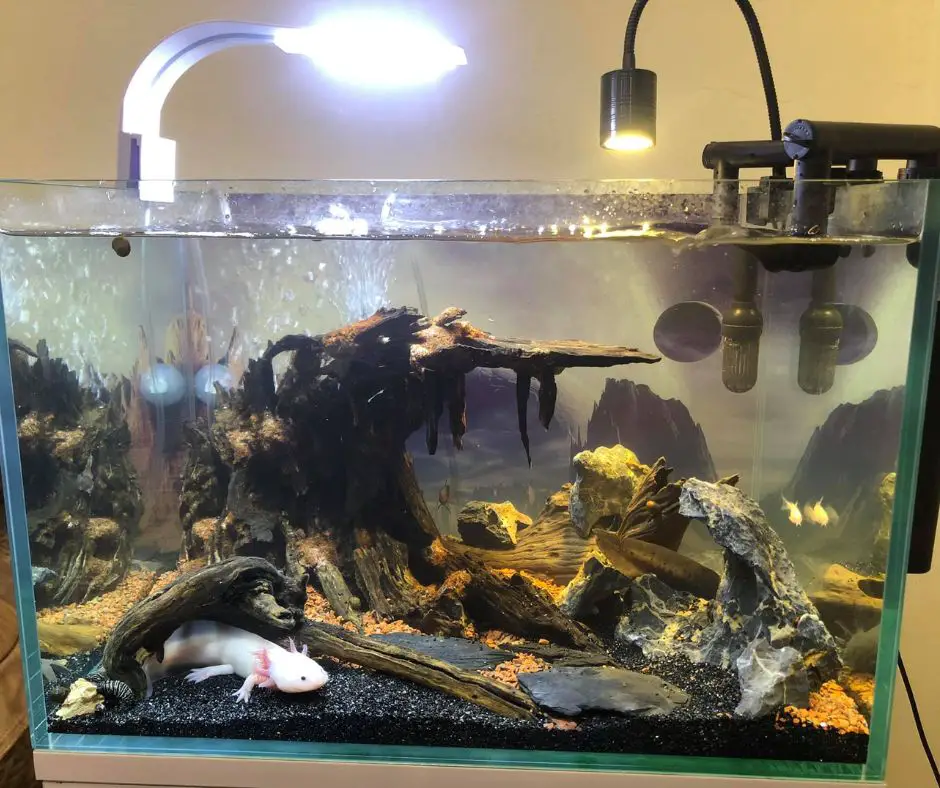
The first step is to determine whether the scratching is normal or related to an illness. To determine this, look for scratching’s underlying indications and symptoms.
Scratching is normal and serves to activate the filamentous cells, as previously stated.
Stress, as well as bacterial and fungal infections, can cause gill scratching.
When an axolotl is stressed, it will show various indicators of stress such as floating, lethargy, and gulping air at the water’s surface.
You’ll see skin sores, redness, and cotton-like growths on an axolotl’s body if it’s scratching its gills due to a bacterial or fungal infection. The next step is to treat each specific cause.
Maintaining normal water quality and conditions is critical for treating and preventing gill scratching.
Regular water changes and the installation of water filters in the tank can help to preserve water quality. Provide good quality water and healthy food if gill scratching is caused by stress.
If an axolotl is seriously infected, a veterinarian can provide antibacterial treatment.
A veterinarian may also suggest that the water be treated with salt. because adding salt to the tank inhibits bacteria from growing in the water and on the axolotl’s skin.
Also read: Axolotl Fungus Treatment
API Aquarium Salt
- Contains one (1) API AQUARIUM SALT Freshwater Aquarium Salt 65-Ounce Box
- Promotes fish health and disease recovery with increased electrolytes
- Improves respiration for fish in freshwater aquariums
- Made from evaporated sea water for all-natural results
- Use when changing water, when setting up a new freshwater aquarium and when treating fish disease
Last update on 2022-12-29 / Affiliate links / Images from Amazon Product Advertising API
Conclusion:
Axolotls scratch their gills due to various reasons such as stress, bacterial infections, fungal infections, and low oxygen levels in the water.
It is natural for an axolotl to scratch its gills on occasion. When an axolotl scratches, you must detect the signs and symptoms of an underlying disease.
The health of axolotls is determined by the tank’s water quality. Stress, skin diseases, and gill itching are all symptoms of poor water quality.
To keep axolotls healthy and happy, check water parameters and change the tank water on a regular basis.
